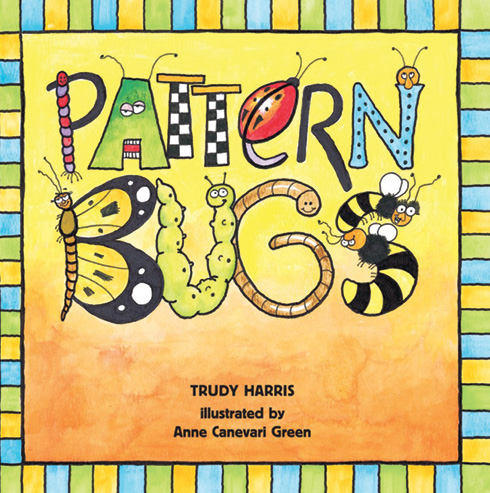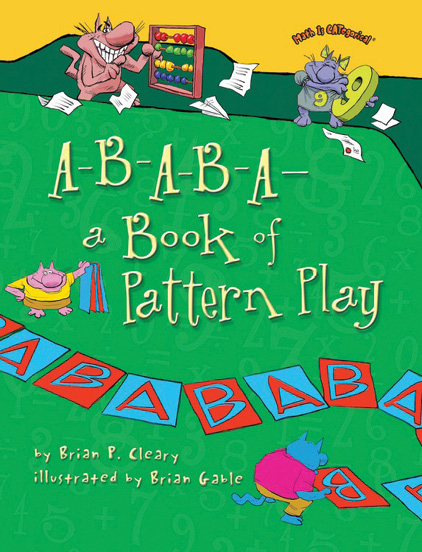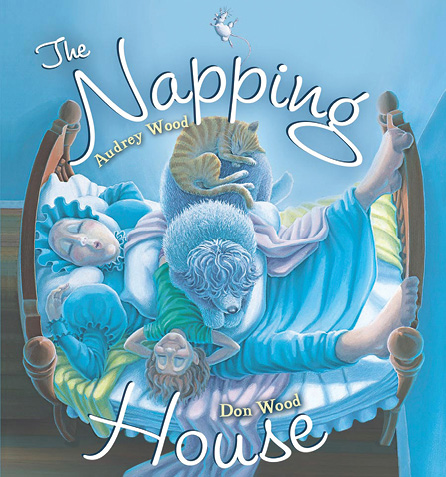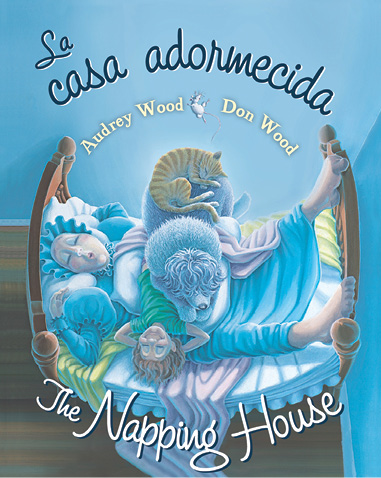Now Read This! Pattern Books

You are here
Patterns have a sequence that repeats in a predictable manner. Through sounds, words, and pictures, these books illustrate two different types of patterns: repeating and growing. When helping your preschoolers understand how to identify, label, and describe patterns, let these books assist you!
Pattern Bugs
 by Trudy Harris. Illus. by Anne Canevari Green. 2001. Lerner Publishing Group.
by Trudy Harris. Illus. by Anne Canevari Green. 2001. Lerner Publishing Group.
This highly visual book uses language and illustrations to emphasize repeating patterns.
“Skitter-scoot-crawl, / Skitter-scoot-crawl. /
A beetle / moves along a wall. /
Skitter-scoot-crawl, / Skitter-scoot-crawl, / Skitter-scoot . . .”—What comes next?— “Crawl.”
Skitter-scoot-crawl is a repeating unit, and these words repeat in an ABC pattern. The first part (skitter) is A, the second part (scoot) is B, and the third part (crawl) is C. The same ABC pattern rule is repeated along the border of each page, in the beetle’s hats, in the kites, and on the spots on the bugs themselves. Harris includes multiple patterns on a page that follow the same rule.
TRY THIS. Read this book aloud, a few pages at a time. Do children notice that on each page all the patterns follow the same rule? Can they name the rule (such as AB, ABC, or AAAB)? Try having each child create her own signature sound pattern. The teacher could start it off by saying, “My sound pattern is clap, clap, stomp, clap, clap, stomp. What’s your sound pattern?” Children may also enjoy drawing their own pattern bug page, creating multiple patterns that follow the same rule.
A-B-A-B-A—A Book of Pattern Play
 by Brian P. Cleary. Illus. by Brian Gable. 2012. Lerner Publishing Group.
by Brian P. Cleary. Illus. by Brian Gable. 2012. Lerner Publishing Group.
Using fun rhythms and amusing illustrations of animals, this book helps children understand the structure of repeating patterns. The catchy text tells readers that a pattern is “sort of an arrangement of colors, shapes, or things, in a way that is predictable, as in the row of rings. / See the colors? Green, red, gold, then green, red, gold, green, red. / Once you catch on, you can guess exactly what’s ahead.” As you move through the book, the patterns become more difficult, such as skip counting, (counting by twos, fives, and tens). Children will study skip counting in elementary school, but preschool teachers can expose them to the idea, too. Children may have heard the chant, “2, 4, 6, 8, who do we appreciate?” This is an example of skip counting by 2.
TRY THIS. Preview this book before you read it to children, and decide which patterns to identify and discuss. Encourage children to re-create the pattern rules with different objects. Have children line up in an AB pattern: 3-year-old, 4-year-old, 3-year-old, 4-year-old. Try setting up a store for children to make and sell “pattern snakes” and “pattern necklaces.” (Use pipe cleaners and beads, or any materials you have, to make snakes and necklaces.) Some children will be able to create their own repeating patterns right away; others will need a few examples to copy. Try having a pattern of the day. If the pattern of the day is ABB, draw attention to the pattern name, “Today is ABB pattern day!” Children can make ABB sound patterns during circle time (clap, pat, pat, clap, pat, pat) and later create ABB patterns using art materials.
The Napping House
 by Audrey Wood. Illus. by Don Wood. 1991. Houghton Mifflin Harcourt.
by Audrey Wood. Illus. by Don Wood. 1991. Houghton Mifflin Harcourt.
In the napping house—where everyone is sleeping—a cozy bed is piled with a snoring granny, a dreaming child, a dozing dog, a snoozing cat, and a slumbering mouse! All is quiet, until the appearance of . . . a wakeful flea! Before you know it, no one is sleeping!
This classic rhyming book exposes preschoolers to a new kind of pattern—not a repeating pattern, but a growing pattern. With each creature that joins the pile of sleepers, the story illustrates a plus-one growing pattern. That’s an easy pattern for young children to recognize and extend because it’s the structure of our number system (1, 2, 3, 4, . . .) and often looks like a set of stairs. Growing patterns increase or decrease by a constant amount. Recognizing patterns like this lays the foundation for algebraic thinking.
 TRY THIS. In this book, one additional character per page is added to a stack of sleepers. Try making a chart that shows the growing pattern. Cut out similarly sized squares, one for each character found on each page—for example, you should have the most cut-outs of the granny and only one cut-out of the flea.
TRY THIS. In this book, one additional character per page is added to a stack of sleepers. Try making a chart that shows the growing pattern. Cut out similarly sized squares, one for each character found on each page—for example, you should have the most cut-outs of the granny and only one cut-out of the flea.
Then, on a flannel board, easel, or the floor, create a chart with columns representing the pages of the story. Start with the sleeping granny. Then in each successive column, add the next character to the chart, just like they are piling on the bed. The chart will illustrate the growing pattern—like stairs!—so that children can see the plus-one pattern growing as they read the story.
Book covers: © Lerner Publishing and © Houghton Mifflin Harcourt
This information has been adapted from Games for Young Mathematicians, a program of research in early mathematics at the Education Development Center (EDC), supported by funding from the National Science Foundation and the Heising-Simons Foundation. For more math information and games, visit http://ym.edc.org.
Jessica Mercer Young is a research scientist and developmental and educational psychologist specializing in early learning at Education Development Center.
Kristen E. Reed, project director at EDC, has worked as a teacher, curriculum developer, professional development facilitator, and researcher. For more ways to make math engaging, challenging, and fun, visit ym.edc.org. [email protected]